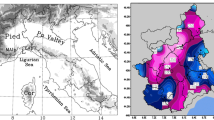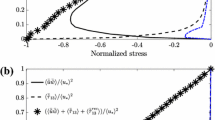Summary
An outline is given of the numerical formulations that have been utilized for medium-range prediction at the European Centre for Medium-Range Weather Forecasts. The sigma-coordinate grid-point model adopted for the first phase of operational forecasting, and the hybrid-coordinate spectral model which replaced it, are described. Particular emphasis is placed on aspects of the time-stepping employed in the spectral model. It is shown how a semi-implicit treatment of the zonal advection of vorticity and specific humidity, and selective use of enhanced horizontal diffusion, enables time-steps to be used which are well over 50% longer than would otherwise be possible in a spectral model with a classical semi-implicit treatment of gravity-wave terms, with negligible computational cost and negligible impact on forecast accuracy, at T 106 resolution at least. Some discussion of the stability of the semi-implicit gravity-wave scheme is also included.
The experimental evidence which led to the operational change from the grid-point to the spectral model is summarized, and the sensitivity of forecasts to the horizontal resolution of the spectral model is illustrated. Both the change in method and increases in resolution result in systematic improvements in the details of cyclone development, and they occasionally have major beneficial impact on the evolution of the forecast in the medium range. Conventional objective verification indicates a much smaller mean improvement of T 106 resolution over T 63 than of T 63 over T 42, although the advantage of T 106 is nevertheless clear-cut. This advantage is more than confirmed by synoptic assessment. Scope for further improvement is indicated by first results from global forecasts with a resolution of T 159. Indications of sensitivity to the magnitude of horizontal diffusion and the resolution of the model orography are also given.
The spectral model was initially used operationally with a 16-level vertical resolution, and the uppermost level at which prognostic variables were held was 25 mb. The results which justified a subsequent change to 19 levels, with increased stratospheric resolution and a 10 mb top level, are presented. In this case the principal medium-range forecast improvement came about because better initial analyses could be produced when the 19-level model was used in data assimilation.
Similar content being viewed by others
References
Arakawa, A., Lamb, V. R., 1977: Computational design of the basic dynamical processes of the UCLA general circulation model.Methods in Computational Physics, Vol. 17,General Circulation of the Atmosphere, ed. by J. Chang, Ac. Press, 173–265.
Asselin, R., 1972: Frequency filter for time integrations.Mon. Wea. Rev.,100, 487–490.
Atlas, R., Ghil, M., Halem, M., 1982: The effect of model resolution and satellite sounding data on GLS model forecasts.Mon. Wea. Rev.,110, 662–682.
Baede, A. P. M., Jarraud, M., Cubasch, U., 1979: Adiabatic formulation and organization of ECMWF's spectral model. ECMWF Tech. Rep. No. 15, 40 pp.
Bates, J. R., McDonald, A., 1982: Multiply-upstream semi-Lagrangian advective schemes: analysis and application to a multi-level primitive-equation model.Mon. Wea. Rev.,110, 1831–1842.
Bengtsson, L., 1981: Numerical prediction of atmospheric blocking—A case study.Tellus,33, 19–42.
Bourke, W., 1974: A multi-level spectral model. I: Formulation and hemispheric integrations.Mon. Wea. Rev.,102, 687–701.
Boville, B. A., 1984: The influence of the polar night jet on the tropospheric circulation in a GCM.J. Atmos. Sci.,41, 1132–1142.
Burridge, D. M., Steppeler, J., Strüfing, R., 1986: Finite element schemes for the vertical discretization of the ECMWF forecast model using linear elements. ECMWF Tech. Rep. No. 54, 48 pp.
Dell'Osso, 1984: High resolution experiments with the ECMWF model: A case study.Mon. Wea. Rev.,112, 1853–1883.
Dent, D., 1987: The ECMWF multitasking weather model. Science and Engineering on Cray Supercomputers: Proceedings of the Third International Symposium. Cray Research Inc., Minneapolis, 35–52.
ECMWF, 1987: Proceedings of 1986 Seminar/Workshop on Observation, theory and modelling of orographic effects. Vol. I. 333 pp.
Gibson, J. K., 1984: A production multi-tasking numerical weather prediction model. ECMWF Tech. Memo No. 91, 22 pp.
Girard, C., Jarraud, M., 1982: Short and medium range fore-cast differences between a spectral and grid point model. An extensive quasi-operational comparison. ECMWF Tech. Rep. No. 32, 178 pp.
Hoskins, B. J., Simmons, A. J., 1975: A multi-layer spectral model and the semi-implicit method.Quart. J. Roy. Meteor. Soc.,101, 637–655.
Jarraud, M., Girard, C., 1984: An extensive quasi-operational comparison between a spectral and a grid-point model. ECMWF Seminar on Numerical Methods for Numerical Weather Prediction, 5–9 September 1983, Reading, U.K. 61–111.
Jarraud, M., Simmons, A. J., 1984: The spectral technique. ECMWF Seminar on Numerical Methods for Weather Prediction, 5–9 September 1983, Reading, U.K., Vol. 2, 1–59.
Jarraud, M., Simmons, A. J., 1985: Development of the high resolution model. ECMWF Tech. Memo. No. 107, 61 pp.
Jarraud, M., Simmons, A. J., Kanamitsu, M., 1988: Sensitivity of medium-range weather forecasts to the use of an envelope orography.Quart. J. Roy. Meteor. Soc.,114, 989–1025.
Lange, A., Hellsten, E., 1984: Results of the WMO/CAS NWP Data Study and Intercomparison Project for Fore-casts for the Northern Hemisphere in 1983. WMO/PWPR Publication Series No. 7, Geneva, 1984.
Machenhauer, B., 1979: The spectral method. GARP Publication, Series No. 17, II, pp. 121–275.
Miyakoda, K., Strickler, R. F., Nappo, C. J., Baker, P. L., Hembree, G. D., 1971: The effect of horizontal grid resolution in an atmospheric circulation model.J. Atmos. Sci.,28, 481–499.
Miyakoda, K., Hembree, G. D., Strickler, R. F., Shulman, L., 1972: Cumulative results of extended forecasts experiments. I: Model performance for winter cases.Mon. Wea. Rev.,100, 836–855.
Phillips, N. A., 1957: A coordinate system having some special advantages for numerical forecasting.J. Meteor.,14, 184–185.
Radinovic, D., 1986: On the development of orographic cyclones.Quart. J. Roy. Meteor. Soc.,112, 927–951.
Ritchie, H., 1987: Semi-Lagrangian advection on a Gaussian grid.Mon. Wea. Rev.,115, 608–619.
Ritter, B., 1984: The impact of an alternative treatment of infrared radiation on the performance of the ECMWF model. In:IRS '84; Current Problems in Atmospheric Radiation. Ed. G. Fiocco. Deepak, Hampton, Virginia, 277–280.
Robert, A., 1981: Stable numerical integration scheme for the primitive meteorological equations.Atmosphere-Ocean,19, 35–46.
Robert, A. J., Hendersen, J., Turnbull, C., 1972: An implicit time integration scheme for baroclinic models of the atmosphere.Mon. Wea. Rev.,100, 329–335.
Robert, A., Yee, T. L., Ritchie, H., 1985: A semi-Lagrangian and semi-implicit numerical integration scheme for multi-level atmospheric models.Mon. Wea. Rev.,113, 388–394.
Sadourny, R., 1975: Compressible flows on a sphere.J. Atmos. Sci.,32, 2103–2110.
Simmons, A. J., 1983: Adiabatic formulation of the ECMWF forecasting system. ECMWF Seminar on Interpretation of Numerical Weather Prediction Products, 13–17 September 1982, Reading, U.K., 59–81.
Simmons, A. J., 1986: Numerical prediction: some results from operational forecasting at ECMWF.Adv. Geophys. 29, 305–338.
Simmons, A. J., 1987: Orography and the development of the ECMWF forecast model. ECMWF Seminar on Observation, Theory and Modelling of Orographic Effects, 15–19 September, 1987, Reading, U.K., Vol. 2, 129–163.
Simmons, A. J., Burridge, D. M., 1981: An energy and angular momentum conserving vertical finite difference scheme and hybrid vertical coordinates.Mon. Wea. Rev.,109, 758–766.
Simmons, A. J., Hoskins, B. J., Burridge, D. M., 1978: Stability of the semi-implicit method of time integration.Mon. Wea. Rev.,106, 405–412.
Simmons, A. J., Jarraud, M., 1984: The design and performance of the new ECMWF operational model. ECMWF Seminar on Numerical Methods for Weather Prediction, 5–9 September 1983, Reading, U.K., Vol. 2, 113–164.
Simmons, A. J., Strüfing, R., 1983: Numerical forecasts of stratospheric warming events using a model with a hybrid vertical coordinate.Quart. J. Roy. Meteor. Soc.,109, 81–111.
Staniforth, A. N., Temperton, C., 1986: Semi-implicit semi-Langrangian schemes for a barotropic finite-element regional model.Mon. Wea. Rev.,114, 2078–2090.
Steppeler, J., 1986: Finite element scheme for the vertical discretization of the ECMWF forecast model using quadratic and cubic elements. ECMWF Tech. Rep. No. 55, 59 pp.
Steppeler, J., 1988: A Galerkin finite-element spectral weather forecast model in hybrid coordinates.Computers and Mathematics with Applications: Series B,16, 23–30.
Tibaldi, S., Ji, L. R., 1983: On the effect of model resolution on numerical simulation of blocking.Tellus,35 A, 28–38.
Tiedtke, M., Geleyn, J.-F., Hollingsworth, A., Louis, J.-F., 1979: ECMWF model parameterisation of sub-grid scale processes. ECMWF Tech. Rep. No. 10, 46 pp.
Tiedtke, M., Slingo, J., 1985: Development of the operational parameterization scheme. ECMWF Tech. Memo. No. 108, 38 pp.
Tiedtke, M., Heckley, W., Slingo, J., 1988: Tropical forecasting at ECMWF: The influence of physical parametrization on the mean structure of forecasts and analysis.Quart. J. Roy. Meteor. Soc.,114, 639–664.
Wergen, W., 1987: Diabatic nonlinear normal model initialization for a spectral model with a hybrid vertical coordinate. ECMWF Tech. Rep. No. 59, 83 pp.
Williamson, D. L., 1978: The relative importance of resolution, accuracy and diffusion in short-range forecasts with the NCAR global circulation model.Mon. Wea. Rev.,106, 69–88.
Author information
Authors and Affiliations
Additional information
With 24 Figures
Rights and permissions
About this article
Cite this article
Simmons, A.J., Burridge, D.M., Jarraud, M. et al. The ECMWF medium-range prediction models development of the numerical formulations and the impact of increased resolution. Meteorl. Atmos. Phys. 40, 28–60 (1989). https://doi.org/10.1007/BF01027467
Received:
Revised:
Issue Date:
DOI: https://doi.org/10.1007/BF01027467




